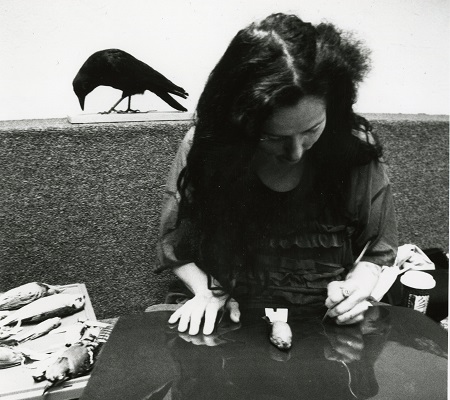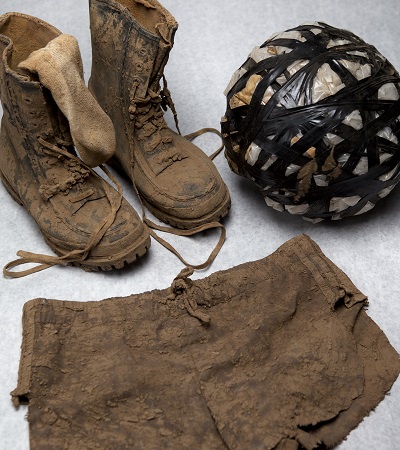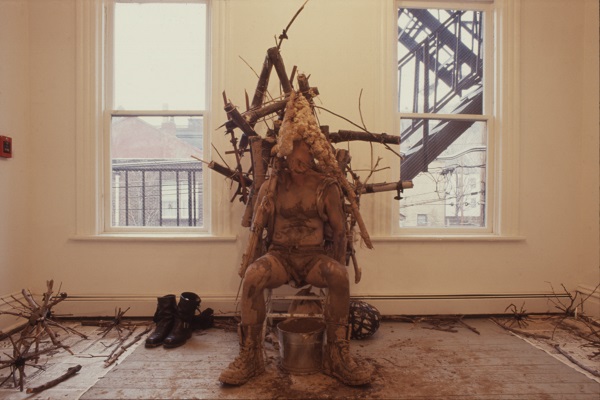 |
Recipient: Mattress Factory Program: Introducing the Mattress Factory’s Active Archive: Programs and Technology to Engage Our Audience Year Awarded: 2013 Grant log number: MA-10-13-0420-13 Website: |
Contact: Michael Olijnyk |
Pictured above: Caption: Wax ex-voto heads from Ann Hamilton’s installation, “Offering,” installed at the Mattress Factory in 1991.
When the Mattress Factory opened its doors in 1977, it envisioned being a place created by artists, supported by artists, and continually enriched by artists. Now, almost 40 years later, the Mattress Factory has evolved into a cornerstone of the national art scene known for helping artists create pieces that speak to the world they live in. When installations were deconstructed after their time at the museum, staff kept visible remnants of the former installations. The question on the eve of their Anniversary quickly became, “How will the Mattress Factory share 40 years of history with the public?”

Forty Years of Site-Specific Installations
The Mattress Factory was founded in 1977 by Barbara Luderowski to support artists working in residence to create site-specific installations. The old Stearns & Foster mattress factory has been home to more than 650 established and emerging artists, who pioneered the development of alternative art forms, and is nationally and internationally recognized as a leader in site-specific contemporary art. Dedicated to providing artists with the space, materials, assistance and freedom to explore new ideas, the museum encourages its artists to take risks, engaging the community through works of art that help explain the world from a different point of view.
And for 40 years, it has done just that.
But once installations are completed and works of art are dismantled, there is still a story that remains – one that is becoming increasingly important for the Mattress Factory to tell.
“Every 10 years, the Mattress Factory publishes a catalog. But with our 40th anniversary around the corner, we began to think that a catalog was such a static way of showing what the organization does, so we started looking at everything we saved over the last four decades and how we can make all the behind-the-scenes information available to as many people as possible,” said Michael Olijnyk, Co-Director of the Mattress Factory.

Digitizing History
In 2013, the Mattress Factory began working with Whirl-i-Gig, creator of CollectiveAccess, to develop a flexible website to digitize and present its archival collection, allowing for a more permanent documentation of the museum’s history. Further, the museum developed educational programs and worked with Whirl-i-Gig to develop a mobile app to make the archival material more accessible and usable by a large and diverse audience. According to the Mattress Factory, the most important goal of the multi-phase project, now known as “P(articipate): An Active Archive” was to engage audiences through digital and actual programs in the art, artists, and creative interdisciplinary thinking that takes place at the museum.
While more and more museums have mastered the art of digitization, the Mattress Factory has gone a step further by creating an app that not only incorporates the story of the building, the stories of the artists, and the stories of the visitors, but also attempts to connect all of those into a meaningful dialogue. The Mattress Factory’s collection of archival material includes a wide variety of installation remnants, sketches, correspondence, photographs, and audiovisual materials that date from 1975 to present. These materials supplement the piece of art that was conceived at the Factory and documents the artistic process that goes into its creation. With these materials, visitors can glean more meaning from the actual art by understanding the process of developing the installation.
Showcasing Site Transformation
The app, which launches next month, will guide users on a historical tour through sites of former artworks. When the user stands in front of a piece of work, the app will guide them through the 10 or 15 pieces that happened in the space over the last 40 years. Through the digital transformation of the space illustrated through the app, the Mattress Factory has taken a digital archive and provided history of the space the art had filled, and the transformation of that space over time.
“We had a bit of a hard time thinking about doing an app because for us the best way to look at a piece of art is to stand in front of it and experience it without any layer in front of you,” said Olijnyk. “So the app is for someone who is interested in looking at the history of the organization. The app is another way to understand the piece that the user is viewing by looking at how the space it resides in transforms throughout the Mattress Factory’s history.

Wider, More Meaningful Connections
Through the digitization project, the Mattress Factory has already been able to connect with a wider and more diverse audience than ever before. “I think that was absolutely our goal in all of this,” said Olijnyk. “We wanted to make what we have done over the last 40 years accessible to as many people as possible. For people who come here and for people who won’t be able to come. That was our goal.”
When asked what has been the project highlight, Olijnyk didn’t miss a beat. “It’s been really fulfilling to look back on our many years of work and remember that all these artists went through a process. So often we see the final product and hardly ever the process it took to get there. This archive helps bridge that gap.”

The Next 40 Years of the Mattress Factory
Though the grant comes to an end at the end of 2016 with the launch of the mobile app, the project is long from over. “IMLS gave us the opportunity to do a life-long project, there is no end to it,” said Olijnyk. “The Mattress Factory is not stopping at the end of the grant. Artists are continually coming to the Factory, and when they leave, we save a little piece of them or their artwork. Over time, we just saved things, and then when you look back so many years later, you realize you have these beautiful drawings or interviews, and those are the things that bring older installations back to life.”
“We always say that The Mattress Factory is not about helping people understand art. It’s about helping people understand who they are and maybe who the person was that made the art that you are looking at. At the Mattress Factory, art is not about art. Art is about life.” – Michael Olijnyk, Co-Director, the Mattress Factory
Resources
- Mattress Factory Blog: http://artyoucangetinto.blogspot.com/
- Mattress Factory Facebook: https://www.facebook.com/MattressFactory
- Mattress Factory Twitter: https://twitter.com/MattressFactory
- Mattress Factory Flickr: https://www.flickr.com/photos/mattressfactory/
- Mattress Factory YouTube: https://www.youtube.com/user/MattressFactory